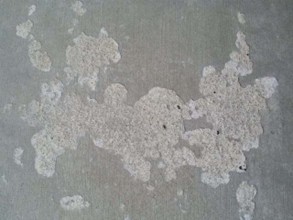Icemelter and new concrete (12 months old!)
What Causes the Chipping and Spalling of Concrete in Winter
How to Repair Chipped and Spalled Concrete Caused by Winter Weather

Concrete is one of the most durable and widely used building materials in the world. However, even this strong material can deteriorate when exposed to harsh winter conditions. One of the most common issues seen during cold weather is the chipping and spalling of concrete surfaces — a process where the surface flakes, peels, or breaks away in small fragments. Understanding the causes of this damage is key to preventing it and extending the lifespan of concrete structures.
The primary cause of winter concrete damage is the freeze–thaw cycle. Concrete is naturally porous, meaning it contains tiny capillaries and air pockets that can absorb water. When temperatures drop below freezing, the water trapped within these pores expands as it turns to ice — by nearly 9% in volume.
This expansion puts internal pressure on the surrounding concrete matrix. Repeated freezing and thawing cycles gradually weaken the surface, causing microcracks that eventually lead to chipping and spalling.
Poorly air-entrained concrete is especially susceptible to this problem because it lacks enough tiny air bubbles to accommodate the pressure caused by expanding ice.
Another major contributor to winter concrete damage is the use of deicing chemicals, such as sodium chloride (rock salt), calcium chloride, and magnesium chloride. While these salts are effective for melting ice, they can harm concrete in two ways:
| * Chemical reaction: Certain deicers, especially those containing calcium or magnesium, can chemically react with concrete, leading to surface scaling and weakening. |
| * Increased saturation: Deicing salts lower the freezing point of water, which means that more liquid water can penetrate into the concrete even at subfreezing temperatures. This added moisture exacerbates freeze–thaw damage. |
Moreover, when the metled ice water refreezes, it expands within the surface layer, accelerating flaking and chipping.
Concrete that was improperly mixed, finished, or cured is much more likely to deteriorate in winter conditions. Some common quality issues include:
| * High water-to-cement ratio: Too much water in the mix creates excessive porosity, allowing more moisture to penetrate. |
| * Inadequate curing: Concrete that did not cure properly (too fast or under poor moisture conditions) can have a weak surface layer. |
| * Insufficient air entrainment: Without enough microscopic air bubbles, concrete has no relief system for internal freezing pressure. |
The result is a surface that cannot resist the stress caused by freezing and thawing cycles.
Physical wear and tear during the winter also contribute to chipping. Snowplows, shovels, and even vehicle tires can scrape and abrade the already weakened surface of the concrete. When combined with freeze–thaw stress and deicing chemicals, this mechanical damage can rapidly accelerate surface spalling.
Sometimes, protective coatings or sealers can inadvertently trap moisture inside the concrete. If moisture gets beneath a non-breathable sealer and freezes, it can cause pressure buildup beneath the surface, leading to surface delamination or flaking.
To minimize chipping and spalling, consider these preventative measures:
| 1. Use air-entrained concrete for outdoor applications. |
| 2. Ensure proper curing — keep concrete moist and protected for at least seven days after placement. |
| 3. Apply a breathable, water-repellent sealer before winter to limit water absorption. |
| 4. Avoid harsh deicing salts; use sand or non-chloride alternatives instead. |
| 5. Repair cracks early to prevent water infiltration. |
Chipping and spalling of concrete in winter are typically caused by a combination of moisture, freezing temperatures, chemical exposure, and mechanical stress. Understanding how these factors interact allows property owners, engineers, and contractors to take proactive steps to protect concrete surfaces. With proper design, quality materials, and regular maintenance, concrete can withstand even the harshest winter conditions for decades.